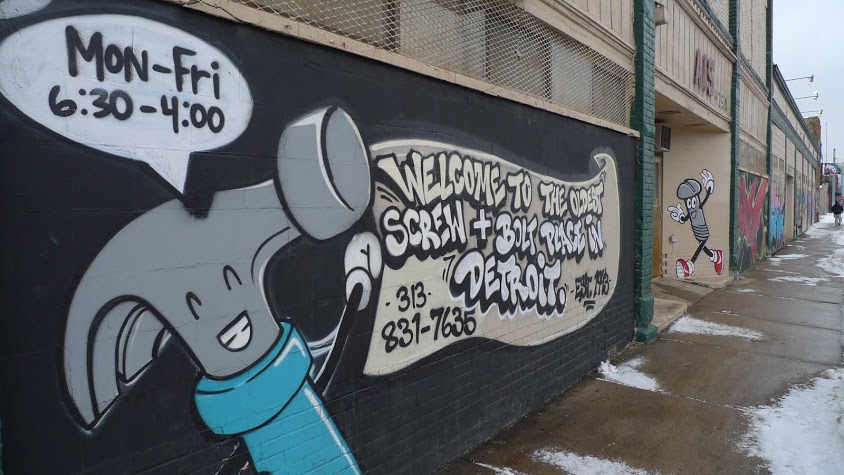A choice for cities: Destroy graffiti or restrict it
Controlling graffiti – whether by coaxing artists to paint in legal zones, or by taking a zero-tolerance, immediate-cleanup approach – has bedeviled cities at least since ancient Rome. So it’s no surprise that Michigan’s urban areas are taking a variety of approaches as well.
Saginaw takes both approaches. The city treats most graffiti as vandalism, unleashing volunteers to eradicate drawings as soon as they are reported.
“If you very quickly make it go away, it has a tendency not to come back,” said John Stemple, chief of code enforcement. Stemple said some spots are perennially tagged, including one “that will never fall apart because it has 79 coats of paint on it.”
But Saginaw allows some legal graffiti, an idea first proposed by an artist the city was trying to stop. Artist Eric Schantz had taken to painting through town all the plywood he could find: “Simple landscapes, skyscapes, that kind of thing,” he said. It was a way to protest the vacancy taking hold in the city, if only with a symbolic gesture. But then it became something else.
“I went to the city,” said Schantz, 37. “They were having problems with straight-up vandalism. I told them they can’t stop it, so why don’t we make an area where people can do it.”
The idea of “mural districts,” he said, offers graffiti artists a chance to “get your art out and not get in trouble for it.” By definition, he said, a mural district would have to be in an area with lots of blank, open walls to paint; it would have to be in a central city. And then what would happen?
“If you want to get old buildings redeveloped, you need to create interest in it,” said Schantz. What better way?
While Schantz was able to paint quite a few walls legally in Saginaw (and has even made a fan out of Semple, the code enforcer) other efforts to funnel artists into legal spaces have made for impressive public art, but haven’t yet alleviated the problem in any significant way.
In the Grand River Creative Corridor in Detroit, where artists have been invited to claim large canvases, the streetscape is a lot more colorful, but illicit graffiti still exists, said Derek Weaver, who organized the painting of buildings in the west-side neighborhood. It was done with building owners’ permission but without city approval.
“Graffiti vandalism was on every single one of these buildings before we started this,” said Weaver. “And a lot of the vandalism has been curtailed. But it’s not the overall solution for everywhere. Like everything else, it has to be the right conditions.”
A legal graffiti zone is, in many ways, contrary to the very idea of graffiti, which gets much of its appeal (for those who do it) from its outsider status.
Elizabeth Currid-Halkett, an associate professor at the University of Southern California, told Fast Company magazine, “When you see graffiti, it’s really a sign of many more interesting creative things going on.” Murals painted legally by better-known artists go hand-in-hand with more ragged taggers’ work: “You don’t have one without the other,” Currid-Halkett said. “They’re both big components of graffiti subculture.”
With most graffiti artists’ messages consisting mainly of their names, the legit approach doesn’t have many fans.
Flint’s mayor, Dayne Walling, certainly isn’t: “There’s always going to be a certain number of individuals who are putting up graffiti and tags, that comes with living in an urban environment,” he said. Its swift removal is in line with the so-called “broken window theory” of policing; that by reacting quickly to vandalism and other petty crime, residents will take more pride in their community and the rate of serious crime will recede. So the city spent part of its $100,000 Cities of Service grant on removing 5,000 square feet of graffiti last year, Walling said. “We treat it like trash, weeds, abandoned tires.”
See what new members are saying about why they donated to Bridge Michigan:
- “In order for this information to be accurate and unbiased it must be underwritten by its readers, not by special interests.” - Larry S.
- “Not many other media sources report on the topics Bridge does.” - Susan B.
- “Your journalism is outstanding and rare these days.” - Mark S.
If you want to ensure the future of nonpartisan, nonprofit Michigan journalism, please become a member today. You, too, will be asked why you donated and maybe we'll feature your quote next time!


 A business on Grand River in Detroit turned its signage over to local artists, who chose to animate the tools sold within. (Photo by Nancy Derringer)
A business on Grand River in Detroit turned its signage over to local artists, who chose to animate the tools sold within. (Photo by Nancy Derringer)